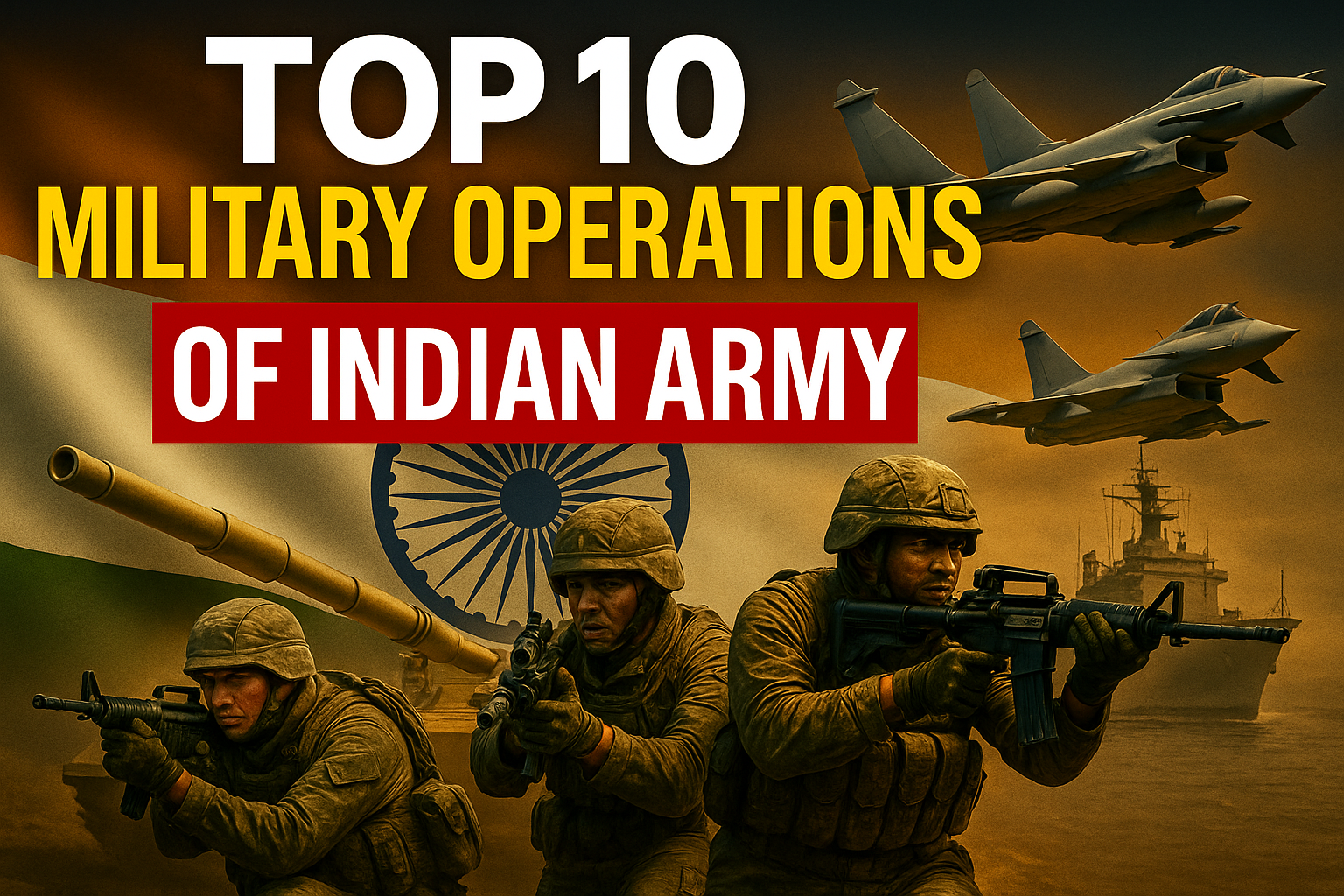Top 10 military operations of Indian Army:
Operation Sindoor has recently brought the Indian Army into the national spotlight once again, highlighting its continued commitment to safeguarding the nation and providing humanitarian support in times of crisis. While this latest operation is making headlines, it is important to remember that the Indian Army has a long and proud history of executing some of the most courageous and strategically significant military operations. These missions have demonstrated India’s military strength, tactical acumen, and the unflinching bravery of its soldiers in both wartime and peacetime.
Over the decades, several operations have etched their place in history due to their sheer impact and execution. These include Operation Vijay (liberation of Goa, 1961), Operation Meghdoot (Siachen Glacier, 1984), Operation Blue Star (Golden Temple, 1984), Operation Cactus (Maldives intervention, 1988), Operation Pawan (IPKF in Sri Lanka, 1987), Operation Rakshak (counter-insurgency in Jammu & Kashmir), Operation Parakram (post-Parliament attack mobilization, 2001), Operation Rhino (counter-insurgency in Assam), Operation All Out (anti-terrorist drive in Kashmir), and Operation Surya Hope (Uttarakhand flood rescue, 2013).
These operations reflect the Indian Army’s versatility — from high-altitude warfare to anti-terror operations and humanitarian missions. Each operation is a testament to India’s unwavering defense spirit and the valor of its armed forces.
Watch our youtube video on Top 10 military operations of Indian Army:
Top 10 military operations of Indian Army:
Operation Peace

- Operation Peace was a military action by India in November 1947 to annex the princely state of Junagadh after its Nawab’s decision to accede to Pakistan.
- Junagadh had a Hindu majority but was ruled by a Muslim Nawab, Muhammad Mahabat Khan III, who chose to accede to Pakistan.
- India contested the decision, citing the region’s geographical location and demographic majority, and demanded Junagadh join India.
- On 9 November 1947, Indian forces entered Junagadh, and the Nawab fled to Pakistan, leading to a smooth takeover by India.
- A plebiscite held in February 1948 saw 99% of Junagadh’s population voting to join India.
- Junagadh was officially integrated into India, though Pakistan continues to claim the state as part of its territory.
Operation Polo:

- Operation Polo was a military action launchedn September 1948 to annex the princely state of Hyderabad.
- The Nizam of Hyderabad wanted to remain independent after India’s independence, refusing to join India or Pakistan.
- The situation worsened due to violence by the Razakars, a private militia supporting the Nizam.
- India carried out the operation as a “police action” to restore law and order and avoid international backlash.
- The Indian Army, led by Major General J.N. Chaudhuri, defeated the Nizam’s forces in five days.
- Hyderabad surrendered on 17 September 1948,
Operation Vijay:

- Operation Vijay was the Indian military operation launched to liberate Goa from Portuguese colonial rule in December 1961.
- Goa, along with Daman and Diu, was the last remaining Portuguese colony in India.
- The operation was prompted by the refusal of Portugal to cede control over Goa, despite India’s diplomatic efforts.
- Indian forces—comprising the Indian Army, Navy, and Air Force—entered Goa on 18 December 1961.
- The Portuguese resistance was minimal, and after 36 hours of fighting, the operation led to the surrender of Portuguese forces on 19 December 1961.
- Goa, Daman, and Diu were subsequently integrated into the Indian Union, ending over 450 years of Portuguese rule.
- Operation Vijay was a significant step in India’s post-independence territorial consolidation.
Operation Trident:

- Operation Trident was a naval offensive launched by the Indian Navy on 4 December 1971 during the Indo-Pak war.
- The operation targeted the Karachi Harbour, Pakistan’s main naval base and port city.
- It involved the use of missile boats (Osa-class) supported by other vessels, marking India’s first use of anti-ship missiles in combat.
- The Indian Navy sank or severely damaged multiple Pakistani vessels, including PNS Khyber, and set Karachi’s oil storage tanks on fire.
- The operation was a huge success with no Indian casualties, and it crippled Pakistan’s naval capabilities.
- The victory is commemorated every year as Indian Navy Day on 4 December.
Operation Meghna Heli Bridge
- Operation Meghna Heli Bridge was a bold airborne operation by the Indian Army during the 1971 Indo-Pak War, specifically in the Eastern sector (Bangladesh Liberation War).
- The operation aimed to bypass the heavily defended Meghna River, which was a major natural obstacle to the Indian advance toward Dhaka.
- Indian forces, led by Lt Gen Sagat Singh, used helicopters to airlift troops of the IV Corps across the river, creating a “heli bridge” in lieu of a physical one.
- The operation was carried out using Mi-4 helicopters of the Indian Air Force, airlifting over 600 troops over several sorties.
- The move surprised Pakistani forces and allowed India to rapidly advance toward Dhaka, significantly accelerating the fall of East Pakistan.
Operation Meghdoot:
- Operation Meghdoot was launched by India on 13 April 1984 to capture the Siachen Glacier in Jammu and Kashmir.
- It was the first military operation in the world conducted at such high altitudes (over 20,000 feet).
- The operation was carried out by the Indian Army and Indian Air Force.
- India preempted Pakistan by occupying key passes like Bilafond La, Sia La, and Saltoro Ridge.
- Major R.S. Sandhu and Lt. Gen. Prem Nath Hoon played key roles in the success of the mission.
- India has maintained control over the Siachen Glacier since 1984, despite ongoing challenges and extreme weather conditions.
Operation Blue Star:
- Operation Blue Star was a military operation carried out by the Indian Army in June 1984 to remove militants led by Jarnail Singh Bhindranwale from the Golden Temple complex in Amritsar, Punjab.
- The militants had fortified the temple and were demanding greater autonomy for Punjab, threatening national security.
- The operation was ordered by Prime Minister Indira Gandhi after failed negotiations and rising violence in the state.
- It was launched on the night of 3–6 June 1984, involving tanks, artillery, and thousands of troops.
- The operation resulted in heavy casualties, including militants, many civilians, and soldiers, and caused major damage to the Akal Takht, a holy Sikh site.
- It sparked outrage among Sikhs worldwide, leading to Indira Gandhi’s assassination by her Sikh bodyguards on 31 October 1984.
Operation Pawan:
- Operation Pawan was launched in 1987 by the Indian Peace Keeping Force (IPKF) in Sri Lanka under the Indo-Sri Lanka Accord.
- The goal was to disarm the LTTE (Liberation Tigers of Tamil Eelam) and restore peace in the region.
- Initially intended as a peacekeeping mission, it turned into a full-scale military conflict with the LTTE.
- At its peak, over 100,000 Indian troops were deployed in northern and eastern Sri Lanka.
- Operation Pawan failed to fully disarm the LTTE, and the mission became highly controversial in India.
- The IPKF was withdrawn by 1990 after political changes in both India and Sri Lanka.
Operation Cactus:
- Operation Cactus was launched by India in November 1988 to thwart a coup attempt in the Maldives.
- A group of Sri Lankan Tamil mercenaries, backed by a Maldivian businessman, tried to overthrow President Maumoon Abdul Gayoom.
- The Maldivian government requested India’s assistance, and India responded within hours.
- The Indian forces secured key installations, rescued the president, and restored order within hours of landing.
- The fleeing mercenaries hijacked a ship, but the Indian Navy intercepted and captured them.
- Operation Cactus was praised internationally and showcased India’s ability to act as a regional stabilizer in South Asia.
Operation Black Tornado:
- Operation Black Tornado was the counter-terrorism operation conducted by India’s National Security Guard (NSG) during the 26/11 Mumbai terror attacks in November 2008.
- It was launched to flush out terrorists from major attack sites: Taj Mahal Palace Hotel, Oberoi Trident Hotel, and Nariman House.
- The operation began on 28 November 2008 and concluded on 29 November 2008, after neutralizing the last of the attackers.
- NSG commandos rescued hundreds of hostages and eliminated multiple terrorists during room-to-room searches.
- Operation Black Tornado ended with 9 terrorists killed, 1 (Ajmal Kasab) captured, and over 160 civilians dead, marking it one of India’s deadliest terror attacks.
You May Also Like:
Static GK:
World Heritage Sites in India! State wise! Download PDF!
Ten (10) Color of Economy! Orange Economy, White Economy etc.
CUET GK 2025-Most Important Days! Download PDF!
CUET GK 2025-Most important Books & Authors. Download pdf!
Top MCQs on National Park in India! Download PDF for free!
CUET 2025 GK-Largest & Smallest in India! Download PDF!
Top 100 Most Important Current Affairs MCQs-April Month
Angola President Visit to India: Key Outcomes
Award & Honours: Important Topics for CUET GK 2025 with PDF!


















Leave a Reply